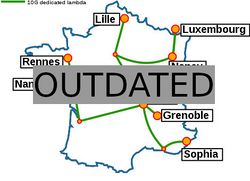Grid5000:Home: Difference between revisions
Ddelabroye (talk | contribs) No edit summary |
No edit summary |
||
| Line 7: | Line 7: | ||
Key features: | Key features: | ||
* provides '''access to a large amount of resources''': 1000 nodes, 8000 cores, grouped in homogeneous clusters, and featuring various technologies: 10G Ethernet, Infiniband, GPUs, Xeon PHI | * provides '''access to a large amount of resources''': 1000 nodes, 8000 cores, grouped in homogeneous clusters, and featuring various technologies: 10G Ethernet, Infiniband, Omnipath, GPUs, Xeon PHI | ||
* '''highly reconfigurable and controllable''': researchers can experiment with a fully customized software stack thanks to bare-metal deployment features, and can isolate their experiment at the networking layer | * '''highly reconfigurable and controllable''': researchers can experiment with a fully customized software stack thanks to bare-metal deployment features, and can isolate their experiment at the networking layer | ||
* '''advanced monitoring and measurement features for traces collection of networking and power consumption''', providing a deep understanding of experiments | * '''advanced monitoring and measurement features for traces collection of networking and power consumption''', providing a deep understanding of experiments | ||
Revision as of 08:25, 17 September 2018
|
Grid'5000 is a large-scale and versatile testbed for experiment-driven research in all areas of computer science, with a focus on parallel and distributed computing including Cloud, HPC and Big Data. Key features:
Older documents:
|
Random pick of publications
Five random publications that benefited from Grid'5000 (at least 2927 overall):
- Dorian Goepp, Fernando Ayats Llamas, Olivier Richard, Quentin Guilloteau. ACM REP24 Tutorial: Reproducible distributed environments with NixOS Compose. 2024, pp.1-3. hal-04613983 view on HAL pdf
- Diego Amaya-Ramirez. Data science approach for the exploration of HLA antigenicity based on 3D structures and molecular dynamics. Bioinformatics q-bio.QM. Université de Lorraine, 2024. English. NNT : 2024LORR0071. tel-04708399 view on HAL pdf
- Jolan Philippe, Antoine Omond, Hélène Coullon, Charles Prud'Homme, Issam Raïs. Fast Choreography of Cross-DevOps Reconfiguration with Ballet: A Multi-Site OpenStack Case Study. SANER 2024: IEEE International Conference on Software Analysis, Evolution and Reengineering, Mar 2024, Rovaniemi, Finland. pp.1-11, 10.1109/SANER60148.2024.00007. hal-04457484 view on HAL pdf
- Reda Khoufache, Anisse Belhadj, Mustapha Lebbah, Hanene Azzag. Distributed MCMC Inference for Bayesian Non-parametric Latent Block Model. 28th Pacific-Asia Conference on Knowledge Discovery and Data Mining, PAKDD 2024, May 2024, Taipei, Taiwan. pp.271-283, 10.1007/978-981-97-2242-6_22. hal-04623748 view on HAL pdf
- Chanattan Sok, Laurent d'Orazio, Reyyan Tekin, Dimitri Tombroff. WebAssembly serverless join: A Study of its Application. International Conference on Scientific and Statistical Database Management (SSDBM), Jul 2024, Rennes France, France. pp.1-4, 10.1145/3676288.3676305. hal-04722875 view on HAL pdf
Latest news
Failed to load RSS feed from https://www.grid5000.fr/mediawiki/index.php?title=News&action=feed&feed=atom: Error parsing XML for RSS
Grid'5000 sites
Current funding
As from June 2008, Inria is the main contributor to Grid'5000 funding.
INRIA |
CNRS |
UniversitiesUniversité Grenoble Alpes, Grenoble INP |
Regional councilsAquitaine |


